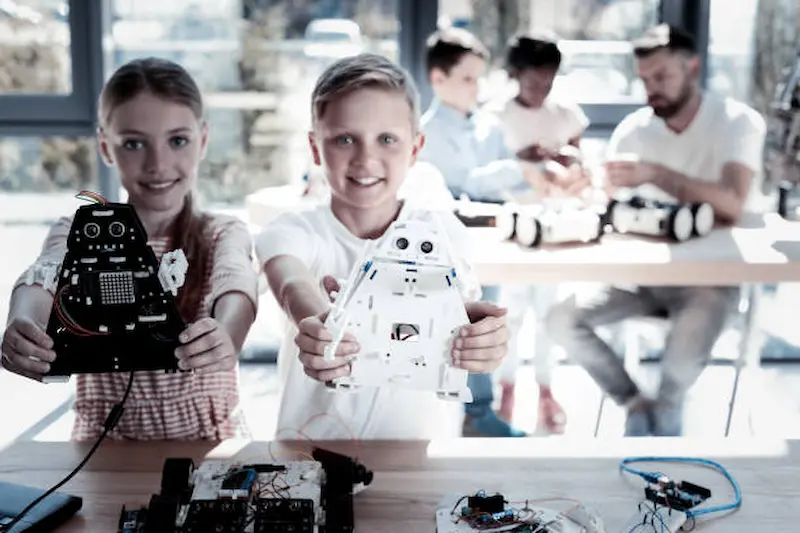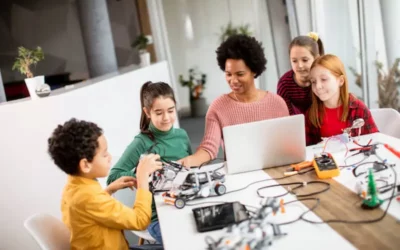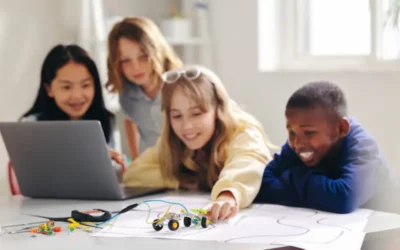From being merely factory equipment to being an essential part of our daily lives, robots have gone a long way.It is crucial to continue learning about the wonders of robotics in a time when technology is developing at an alarming rate. The possibilities range from self-driving automobiles navigating our streets to humanoid robots assisting physicians in operating rooms. Let’s explore the fantastic world of robots and see how they are transforming various industries, enhancing our quality of life, and even erasing the distinction between science fiction and reality.
In this article, we will discover seven fascinating facts about robotics that will pique your curiosity and change the way you see these mechanical marvels.
Table of contents
7 Fun Facts About Robots

1.The History of Robots
Robotics has a far longer history than was once believed. Their beginnings can be found in antiquity, when the ancient Greeks developed early prototypes using brilliant ideas, like water clocks and mechanical motors. These early creations were a reflection of humankind’s original desire to accomplish tasks through the creation of their own labor and the expression of a technologically enhanced way of life.
However, the modern definition of the word “robot” was developed more subsequently, in the early 20th century, by the Czech playwright Karel apek. In his 1920 play “R.U.R.” (Rossum’s Universal Robots), he made an appearance. The piece explored the concept of mechanical beings created to serve humans. This significant change in language marks a turning point in how we see robots and their capabilities
It’s really interesting to watch how the idea of robotics evolved over the centuries, evolving from an ancient technological fascination to the sophisticated AI-powered machines we face today.This evolution has not only changed industries but created conversations of the ethical and social implications of our ever-evolving robotic universe.
2. Robots in Space Exploration
In settings that may be inaccessible to people, such as the harsh surface of Mars, robots have unquestionably played a crucial role in space exploration. Among these amazing robotic explorers are the Mars rovers. The story of the red planet is being told by Curiosity and Persistence. the process by which history is created provides us with priceless information
The fact that those courageous machines are being operated from hundreds of thousands of kilometres away on Earth is virtually mind-boggling. They go over the Martian landscape, carry out research, and send back sophisticated images, all carefully managed internally by a team of scientists and engineers. This technical achievement not only increases our knowledge of Mars, but it also demonstrates human inventiveness and our incapability to quench our thirst for information past our global.
3. AI-Powered Chatbots
Chatbots have become a crucial component of customer support in the digital age. These AI-enabled robots are excellent at conversing with people in real time, resolving issues with ease, and offering crucial support. Their introduction has ushered in a revolution in how businesses connect with their clients, fundamentally altering the field of client interactions.
Chatbots stand out because they can deliver information instantaneously, around-the-clock, and without interference from people. They work tirelessly to complete mundane duties while consistently giving clients with helpful information and quick fixes. In today’s fast-paced digital environment, this feature not only improves customer satisfaction but also considerably lowers reaction times, a crucial metric.
Robotics courses for kids often incorporate exciting technologies like AI-powered chatbots, offering young learners a hands-on experience in building and interacting with intelligent machines.
Additionally, chatbots are adaptable tools that may be used to meet a variety of needs. These AI-powered entities may adjust to various company demands, whether it be answering frequently asked inquiries, assisting users with troubleshooting procedures, or even aiding sales. As a result, businesses across a wide range of industries have grown to rely on chatbots as priceless resources for providing exceptional client experiences in the modern day.
AI for kids is an educational opportunity that introduces children to the concepts of Artificial Intelligence in a fun and engaging way, fostering their curiosity and creativity while preparing them for the tech-driven future.
4. Robots in Medicine

Robotic surgery has advanced dramatically, ushering in a new era of precise surgery. These ground-breaking inventions include the da Vinci Surgical System, a contemporary surgical robot prototype that works in unison with doctors to execute intricate procedures with outstanding and non-invasive precision in a small percentage of patients These new technologies have greatly benefited society, not just in terms of improving unstable outcomes for individual patients.
It is hardly ever unexpected that the da Vinci Surgical System is accurate. Its robotic palms are far more dexterous and precise than human hands, and they are capable of navigating even the most intricate body processes. Due to this precision, patients experienced less depression, had shorter hospital stays, and recovered more quickly.
5. Humanoid Robots
Robots that closely resemble humans in appearance and behavior have a variety of applications, ranging from study to entertainment. Sophia is a well-known example of a humanoid robot that resembles a person very closely and is capable of meaningful communication. Sophia is proof that progress will constantly push the boundaries of what is possible.
The idea of humanoid robots has long piqued people’s interest since it combines advanced technology with a tangential affinity for mankind.Robots that are equipped with sophisticated sensors and artificial intelligence aim to emulate our mental and emotional capabilities in addition to our physical characteristics.
Sophia is one of the results of this endeavor. With her animated face and potential to apprehend and react to spoken language, she has captured the eye of audiences around the sector. Beyond entertainment, humanoid robots like Sophia have the potential to revolutionize areas consisting of healthcare, schooling and even customer support.
6. Robots and Artificial Intelligence
Modern robotics’ primary driving force is artificial intelligence (AI), which is profoundly altering how machines interact with their environment. AI algorithms serve a crucial role at the very heart of robotics, enabling those machines to interpret data from and dynamically adapt to their surroundings. With the help of this fantastic hybrid technology, robots can not only comprehend objects but also make difficult judgments and, in some cases, effectively collaborate with people.
Robotics and AI working together represents an innovative cross-industry partnership. This seamless connection has sparked waves of change throughout industries, enhancing performance and raising productivity, whether in manufacturing, healthcare, agriculture, or logistics. Robots equipped with AI can now serve as more than just tools, becoming intelligent companions that improve the human experience.
Learning about robotics for kids involves exploring the fascinating world of robots and artificial intelligence, which can inspire young minds to innovate and create.
7. The Future of Robotics
As technology continues to evolve, the future of robotics is filled with endless possibilities. We can see robots playing an increasingly important role in fields such as education, agriculture and disaster relief. Looking ahead, it is becoming increasingly likely that the convergence of AI, machine learning and sophisticated sensors will provide robots have risen in relation to versatility and capability.
Artificial Intelligence education plays a crucial role in preparing students for the future of robotics, where intelligent machines will continue to transform industries and shape our world. In agriculture, robots equipped with AI-driven precision will labor tirelessly to boost crop yields and minimize resource wastage. These automated agricultural systems will help tackle the pressing issue of food security in an ever-changing world. Likewise, in the context of disaster relief, robots will become invaluable assets for hazardous environments and providing critical assistance to those in need. This will not only reduce human risk but also expedite the process of recovery. As technology continues to steer progress, the synergy between robotics and AI holds the potential to redefine the frontiers of human achievement, offering a glimpse of a future where robots stand as proficient allies in confronting some of society’s most urgent challenges.
Robotics classes for kids offer a glimpse into the future of robotics, where young learners can shape and be part of the evolving landscape of technology.
Conclusion
The conclusion is that the robotics industry is an exhilarating, dynamic one full of discoveries and surprises. The robotics business is a testament to it demonstrates understanding and advancement, from their ancient origins to their crucial role in space exploration, from humanoid robots pushing the boundaries of what is humanlike to the profound impact of AI on their abilities.
Given these seven endearing facts about robots, it is obvious that we have a long way to go before we can join those mechanical marvels. Robots are increasingly impacting our lives, changing the way we work, enhancing our knowledge, and bringing us closer to a time when interaction between humans and machines will be as smooth as it has ever been.
To get your hands on more educational and free resources on coding for kids, robotics for kids, financial education for kids, etc., do check out the BrightCHAMPS Page now!
To get your hands on more such educational and free resources on coding, robotics, game development, etc., do check out the Brightchamps Blog Page now!
Frequently Asked Questions (FAQs)
A1.Robots can replicate comedy through programmed responses, but since they are incapable of feeling real emotions, their sense of humor is manufactured.
A2.Robots do not dream like humans do since they are not conscious and do not have a subconscious.
A3. Robots cannot experience boredom as humans do, as they lack the capacity for subjective emotions.
A4. Robot pets can mimic emotional responses, but these are programmed behaviors, not genuine emotions.
A5. Robots do not have personal preferences, so they do not have a favorite color.
A6. Robots cannot experience love in the human sense, as it requires complex emotions and consciousness.
A7. Robots can create art through algorithms and programming, but their art lacks the emotional depth of human creativity.


 We are an army of educators and passionate learners from BrightChamps family, committed to providing free learning resources to kids, parents & students.
We are an army of educators and passionate learners from BrightChamps family, committed to providing free learning resources to kids, parents & students.













